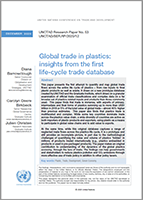
This paper presents the first attempt to quantify and map global trade flows across the entire life cycle of plastics - from raw inputs to final plastic products as well as waste.
It draws on a new prototype database created by UNCTAD and the Graduate Institute, which draws on a granular examination of official trade classifications and compiles data on a far broader set of plastics-related inputs and products than those commonly used.
This paper finds that trade is immense, with exports of primary, intermediate and final forms of plastics summing up to more than US$1 trillion in 2018 or 5% of the total value of global trade - almost 40% higher than previous estimates.
This paper also finds that plastics trade is multifaceted and complex. While some key countries dominate trade across the plastics value chain, a wide diversity of countries are active as both importers of plastic products and exporters, using plastic as a means to participate in global value chains and to add value to exports.
At the same time, while this original database captures a range of neglected trade flows across the plastics life cycle, it is a prototype and still provides an incomplete picture, in part due to the methodological challenges of quantifying the value and volume of plastics 'hidden' in millions of products traded internationally (e.g., plastics embedded in products or used in pre-packaged products).
The paper makes an original contribution to understanding of the dynamics of the global plastics economy, through the lens of trade.
The findings can help governments and stakeholders to reduce plastics pollution and CO2 emissions through more effective use of trade policy in addition to other policy levers.


